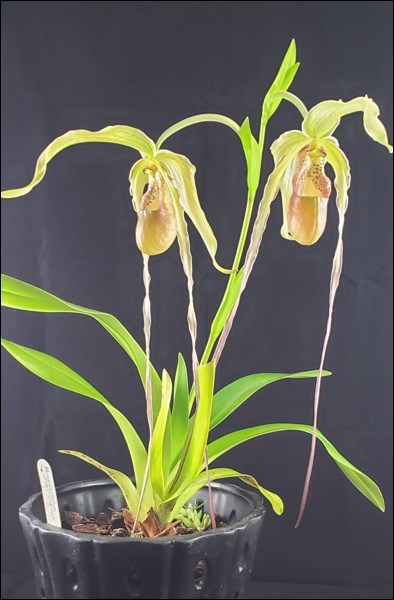This week we are talking orchids for a couple of reasons. One of my favourite people in the world recently passed. Among other things, she was an orchid addict and over her lifetime grew hundreds, if not thousands, of orchids. Sharing her knowledge and helping others to become better stewards was always important to her.
One of her favourite sayings was that orchids are not difficult to grow, just grow the orchid that suits the conditions in your home and be careful, as growing orchids can be addicting.
When growing orchids, it is important to purchase sensibly. Also, for beginners it is more satisfying to buy mature plants that are in bloom. Purchase plants that will suit your growing conditions and also try to duplicate the natural growing conditions of the plant.
An easy orchid to begin with is the Paphiopedilum (paf-ee-oh-ped-i-lum), commonly called the slipper orchid. They were first brought into cultivation in 1819 and are found naturally throughout much of tropical Asia to northern India and the lowlands of the Philippines. The different species are found at various elevations in their natural range. Most are terrestrial (ground-dwelling), but a few are also lithophytic (cliff-perching). While they all trace their ancestry to tropical forests of �鶹��ýAVeast Asia, most of the paphs of easy culture today are hybrids developed from the original jungle-dwelling species.
A cup-like lip called the pouch characterizes the flowers of paphs and by a prominent dorsal sepal, which is often large and strikingly coloured. The flowers of most have a thick, fleshy appearance, and may be so glossy they seem almost to have been polished. An individual flower remains on the plant for up to four months. The plants have stiff, waxy or leathery leaves that are usually either glossy green or mottled. Masses of hairy roots are abundant in the potting medium of well-established plants.
The best way to care for any plant is to provide growing conditions that resemble those found in its native land. Since most of these plants would normally inhabit a shaded jungle floor, they are intolerant of direct, intense sunlight. An east window, which exposes them to direct sun only in the early morning, is ideal.��
They require high humidity of at least 40 to 50 per cent along with gentle but steady air circulation. A small fan in a far corner of the room or a ceiling fan will maintain circulation. Avoid cold drafts as they can cause the flower buds to blast (brown and die). Standing the pots on shallow pans of pebbles and water helps increase the humidity directly around them.
Most paphs are considered “cool growers” with low light requirements. Daytime temperatures should fall in the range of 21 to 27 C. The green-leafed paphs prefer minimum night-time temperatures of about 10 to 13 C, while those with mottled leaves require night temperatures a few degrees warmer.
Finely chopped fir bark makes an excellent growing medium, but bottom drainage should be enhanced with something like Styrofoam “peanuts.” Since they cannot store water, paphs require regular watering, but the medium should never be completely saturated or root rot is likely. Watering should be done early in the day so the foliage can dry before night.
Only mild fertilization is required, so fertilizing with 30-10-20 at about 1 ml/L (1/8 tsp/gal) every six weeks is probably adequate. You may use 2.5 ml (1/2 tsp.) of oyster shell on top of the potting mix to add some additional lime.
Watch for more articles on growing orchids so you too can enjoy these exotic but not so difficult to grow plants.
Hanbidge is the lead horticulturist with Orchid Horticulture. Find us at www.orchidhort.com; by phone at 306-931-4769; by email at [email protected]; on facebook @orchidhort and on instagram at #orchidhort.
��




